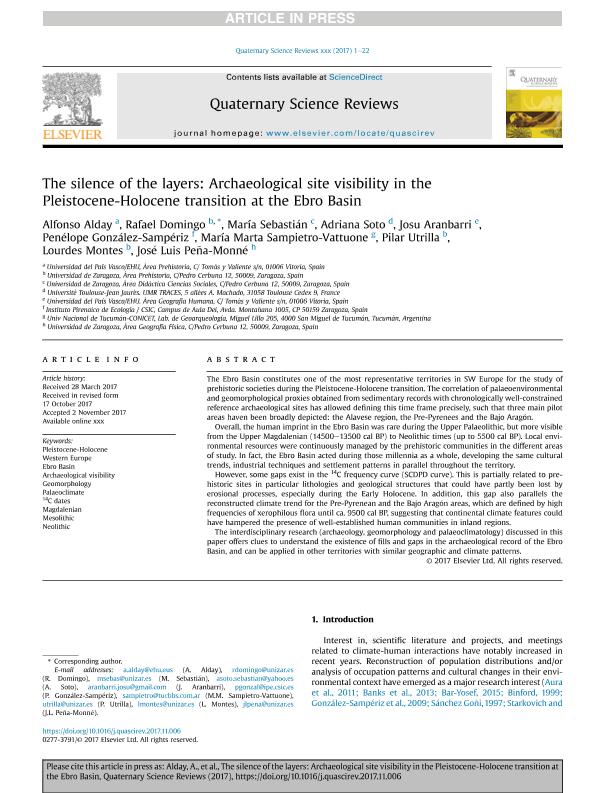Mostrar el registro sencillo del ítem
dc.contributor.author
Alday, Alfonso
dc.contributor.author
Domingo, Rafael
dc.contributor.author
Sebastián, María
dc.contributor.author
Soto, Adriana
dc.contributor.author
Aranbarri, Josu
dc.contributor.author
González Sampériz, Penélope
dc.contributor.author
Sampietro Vattuone, Maria Marta

dc.contributor.author
Utrilla, Pilar
dc.contributor.author
Montes, Lourdes
dc.contributor.author
Peña Monné, José Luis

dc.date.available
2018-12-07T13:37:36Z
dc.date.issued
2018-03
dc.identifier.citation
Alday, Alfonso; Domingo, Rafael; Sebastián, María; Soto, Adriana; Aranbarri, Josu; et al.; The silence of the layers: Archaeological site visibility in the Pleistocene-Holocene transition at the Ebro Basin; Pergamon-Elsevier Science Ltd; Quaternary Science Reviews; 184; 3-2018; 85-106
dc.identifier.issn
0277-3791
dc.identifier.uri
http://hdl.handle.net/11336/66039
dc.description.abstract
The Ebro Basin constitutes one of the most representative territories in SW Europe for the study of prehistoric societies during the Pleistocene-Holocene transition. The correlation of palaeoenvironmental and geomorphological proxies obtained from sedimentary records with chronologically well-constrained reference archaeological sites has allowed defining this time frame precisely, such that three main pilot areas haven been broadly depicted: the Alavese region, the Pre-Pyrenees and the Bajo Aragón. Overall, the human imprint in the Ebro Basin was rare during the Upper Palaeolithic, but more visible from the Upper Magdalenian (14500–13500 cal BP) to Neolithic times (up to 5500 cal BP). Local environmental resources were continuously managed by the prehistoric communities in the different areas of study. In fact, the Ebro Basin acted during those millennia as a whole, developing the same cultural trends, industrial techniques and settlement patterns in parallel throughout the territory. However, some gaps exist in the 14C frequency curve (SCDPD curve). This is partially related to prehistoric sites in particular lithologies and geological structures that could have partly been lost by erosional processes, especially during the Early Holocene. In addition, this gap also parallels the reconstructed climate trend for the Pre-Pyrenean and the Bajo Aragón areas, which are defined by high frequencies of xerophilous flora until ca. 9500 cal BP, suggesting that continental climate features could have hampered the presence of well-established human communities in inland regions. The interdisciplinary research (archaeology, geomorphology and palaeoclimatology) discussed in this paper offers clues to understand the existence of fills and gaps in the archaeological record of the Ebro Basin, and can be applied in other territories with similar geographic and climate patterns.
dc.format
application/pdf
dc.language.iso
eng
dc.publisher
Pergamon-Elsevier Science Ltd

dc.rights
info:eu-repo/semantics/openAccess
dc.rights.uri
https://creativecommons.org/licenses/by-nc-sa/2.5/ar/
dc.subject
14c Dates
dc.subject
Archaeological Visibility
dc.subject
Ebro Basin
dc.subject
Geomorphology
dc.subject
Magdalenian
dc.subject
Mesolithic
dc.subject
Neolithic
dc.subject
Palaeoclimate
dc.subject
Pleistocene-Holocene
dc.subject
Western Europe
dc.subject.classification
Historia

dc.subject.classification
Historia y Arqueología

dc.subject.classification
HUMANIDADES

dc.subject.classification
Meteorología y Ciencias Atmosféricas

dc.subject.classification
Ciencias de la Tierra y relacionadas con el Medio Ambiente

dc.subject.classification
CIENCIAS NATURALES Y EXACTAS

dc.title
The silence of the layers: Archaeological site visibility in the Pleistocene-Holocene transition at the Ebro Basin
dc.type
info:eu-repo/semantics/article
dc.type
info:ar-repo/semantics/artículo
dc.type
info:eu-repo/semantics/publishedVersion
dc.date.updated
2018-12-05T14:45:53Z
dc.journal.volume
184
dc.journal.pagination
85-106
dc.journal.pais
Estados Unidos

dc.journal.ciudad
New York
dc.description.fil
Fil: Alday, Alfonso. Universidad del País Vasco; España
dc.description.fil
Fil: Domingo, Rafael. Universidad de Zaragoza; España
dc.description.fil
Fil: Sebastián, María. Universidad de Zaragoza; España
dc.description.fil
Fil: Soto, Adriana. Université Toulouse-Jean Jaurè; Francia
dc.description.fil
Fil: Aranbarri, Josu. Universidad del País Vasco; España
dc.description.fil
Fil: González Sampériz, Penélope. Consejo Superior de Investigaciones Científicas; España
dc.description.fil
Fil: Sampietro Vattuone, Maria Marta. Consejo Nacional de Investigaciones Científicas y Técnicas. Centro Científico Tecnológico Conicet - Tucumán; Argentina. Universidad Nacional de Tucumán; Argentina
dc.description.fil
Fil: Utrilla, Pilar. Universidad de Zaragoza; España
dc.description.fil
Fil: Montes, Lourdes. Universidad de Zaragoza; España
dc.description.fil
Fil: Peña Monné, José Luis. Universidad de Zaragoza; España
dc.journal.title
Quaternary Science Reviews

dc.relation.alternativeid
info:eu-repo/semantics/altIdentifier/doi/https://dx.doi.org/10.1016/j.quascirev.2017.11.006
dc.relation.alternativeid
info:eu-repo/semantics/altIdentifier/url/https://www.sciencedirect.com/science/article/pii/S0277379117302718
Archivos asociados
